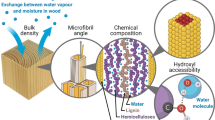Abstract
In this paper, the relationship was studied bwtween the permeability of Pinus koraiensis, Larix gmelinii, Betula platphylla and Populus davidiana and moisture content of wood in the hygroscopic range. The mathenatical model of variation low has been obtained from the relationship between wood and water, The results are as fellow: (1)The relationship betweed wood permeability and the moisture content is in twice curve function in the hygroscopic rang. (2)There is a peak value in tangential permeability, (3) The number of openings per cm of cross sectionand pit—opening average radii reduces by the increaasing of wood moisture content.
Similar content being viewed by others
Refearnces
Siau JF. Flow in Wood, Syracuse Univ Press, Syracuse, 1977
Siau JF. Transport Processes in Wood, Syracuse Univ Press. Syracuse, 1984
Avramidis ST and Siau JF. Experiment in Nonisothermal Diffusion of Moisture in Wood. Wood Sci Technol, 1987, 21: 329–334.
Wang Jinman et al. Wood Permeability, Journal of Northeast Forestry University (English Edition) Vol. 2 No. 1: 91–97. 1991.
Author information
Authors and Affiliations
Rights and permissions
About this article
Cite this article
Jinman, W., Rui, F. & Guangxue, G. Study on the effect of wood moisture content on permeability in the hygroscopic range. J. Northeast For. Univ. 5, 82–87 (1994). https://doi.org/10.1007/BF02875050
Issue Date:
DOI: https://doi.org/10.1007/BF02875050




